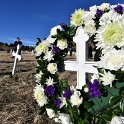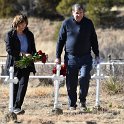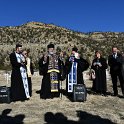Dawson Mining Disasters of the early 1900's
Dawson Cemetery Greek Memorial February 5, 2023
The American Hellenic Educational Progressive Association (AHEPA) Dawson Cemetery memorial paying special respects to the Dawson miners who lost their lives in the 1913 and 1923 mining explosions.
Source: https://chuckspeed.com/Dawson_Association/cemetery_memorial_photos2023/
A Eulogy for Dawson,
New Mexico Where Greek Miners Worked and Died
Rubble is all that marks what was once Dawson, NM. As such, there is too little there to even call it a “ghost town.” Yet, what does remain aside from the odd mound of debris is the town’s cemetery, known both as Dawson Cemetery and Evergreen Cemetery.
Two terrible events led to the cemetery, not the town, being listed in 1992 on the National Register of Historical Places. Today, the Dawson Cemetery can be found at (approximately) four miles Northwest of junction US 64 and Dawson Road. The Dawson Cemetery is as much a part of Greek-American history as it is American labor movement or the history of New Mexico.
By 1869, coal had been discovered on the land that would become Dawson. After a series of owners, the Phelps-Dodge Corporation (PD) bought the area’s mines in 1906. To its credit, PD spared no expense in their efforts to make Dawson a model mining community. In time “the company built spacious homes for its miners, supplied with water from the company’s water system. They also built a four-story brick building which housed PD’s Mercantile Department Store, which sold virtually anything the townfolk might need: food, clothing, shoes, hardware, furniture, drugs, jewelry, baked goods and ice from its own plant.
A modern hospital was built which maintained a staff of five doctors and was complete with a laboratory, surgery, and X-ray equipment. For leisure, the miners enjoyed the use of the company-built movie theater, swimming pool, bowling alley, baseball park, pool hall, golf course, lodge hall, and even an opera house. PD also supported two churches, one Catholic and one Protestant.
Children attended either the Central Elementary School in Downtown Dawson or the Douglas Elementary School on Captain Hill. A large high school building was built that eventually employed 40 teachers, and their athletic teams won many state championships. The company also built a steam-powered electric plant, which powered not only Dawson, but also the nearby towns of Walsenburg, Colorado, and Raton. Providing good-paying jobs for the residents, the extra features of the company town helped keep the employment stable, and under the new management Dawson’s population grew quickly to 3,500 (legendsofamerica.com).” All seemed well and the town grew into approximately 9,000 residents supporting ten coal mines.
Then, on October 22, 1913, an incorrectly set dynamite charge resulted in an enormous explosion in Stag Canon Mine No. 2 that set a tongue of fire one hundred feet out of the tunnel mouth. It was later determined that the explosion was caused by a dynamite charge set off while the mine was in general operation, igniting coal dust in the mine. This was in violation of mining safety laws. Rescue efforts were well-organized and exhaustive, but only a few miners could be rescued. Two hundred and sixty three died in the second-worst mining disaster in American history. Only the December 6, 1907, Monongah Mining disaster was worse. In that underground explosion, 362 workers were killed in a in a Monongah, WV mine.
Of the Dawson 1913 catastrophe worker casualties tolled, 146 were Italians, 35 Greeks, and two rescuers. Despite the fact that they were specially equipped ‘helmet-men’ outfitted with airtanks during their rescue effort James Lurdi and William Poisa inexplicably died. The 35 identified dead Greek miners were: Amargiotu, John; Anastasakis, John; Andres, John; Andres, Pavlo; Andrios, Thelfno; Anezakis, Milos; Anezakis, Stilen; Arkotas, Nick; Bouzakis, Nick; Castenagus, Magus; Colonintres, John; Cotrules, George; Cotrules, Mak; Fanarakis, Michael; Gelas, George; Iconome, Demetrius; Katis, Gust; Ladis, Vassilias; Lopakis, Magus; Magglis, Vassos; Makris, Cost; Makris, George; Michelei, Agostino; Mifinigan, Tones; Minotatis, Emm; Nicolocci, Nick; Papas, Cost; Papas, Nakis; Papas, Strat; Paperi, Mike; Parashas, Manon; Pino, Kros; Sexot, John; Stavakis, Polikronis and Vidalakis, Antonios.
The Phelps-Dodge Corporation paid for all funeral costs for all the victims. In addition the company gave each widow $1,000 dead benefit and $200 to each child.
Given the technological advancements of the 1913-era a Pathe newsreel of the Dawson disaster toured the nation. A 17-minute silent film held by the Prelinger Archives on the Dawson disaster can be seen on YouTube. It is difficult to assess the Prelinger footage, since it seems to be the victim of an array of editorial cuttings. Sources suggest that this newsreel may in fact be a reenactment. It seems likely, then, that the helmeted mine rescue units, seen so prominently in this newsreel, arrived several days after the actual disaster (Salt Lake Tribune October 25, 1913).
Then, on February 8, 1923, yet another explosive disaster struck the Dawson mines in which 123 men died. At the time of that disaster, women who had run in 1913 to the mines to see about their husbands’ safety in 1923 ran to learn of their sons’ safety. From 1880 to 1910, mine accidents claimed thousands of fatalities all across the United States. Annual mining deaths had numbered more than 1,000 a year, during the early part of the 20th century. In addition to deaths, many thousands more miners were injured (an average of 21,351 injuries per year between 1991 and 1999). For the 1923 The Dawson Cemetery Inscriptions and Other Vital Records I can only find the following Greek individuals identified Nick Arvas; Evangelos P. Chiboukis, Evangelos P.; Scopelitis, Criss; Scopelitis; and Paul Stamos among the dead (chuckspeed.com/Dawson_Association/Dawson_Cemetery.pdf).
As anyone visiting can see, prominent in the center of the Dawson Cemetery is a large section of white trefoil crosses composed solely of the collective graves of miners killed both in 1913 and 1923. With so many miners coming from other countries, these tragedies were truly international incidents. In recognition of the importance of this overall site, the cemetery has been placed on the National Register of Historic Places.
In 2013, Greeks in New Mexico observed the “100 Year Anniversary Day of Remembrance” for all who perished in the mine explosions in Dawson. A coalition from Albuquerque St George Greek Orthodox Church and St Elias the Prophet of Santa Fe held memorial services first at the individual churches and then graveside services at the Dawson Cemetery. Greek-American event organizers such as Georgia Maryol and Nicolette Psyllas-Panagopoulos sought to alert the general New Mexican public about this day of observance to much success. Other events included the October 20th commemorative observance at the Raton Museum shared by historians and miner’s descendants.
Then, in 2014, the YouTube video “The Dawson Mines – 100 Years” was aired. The focus of that documentary is on the six Greek miners who died in the tragedy who were all from the village of Volada on the island of Karpathos: Vasilios Manglis, Polihronis Stavrakis, Alex Kritikos, Costas Makris, George Makris, Vasilios Ladis. Ladis had arrived in Dawson only two weeks before the 1913 disaster. This film was produced for the Pan-Karpathian Foundation’s 2014 annual ‘Mnimosino’ memorial service.
Clearly, the Dawson Cemetery is a part of Greek-American history as well as the American labor movement. Therefore, the Dawson Cemetery historical marker must be added to the ever growing list of Greek-American monuments and historic sites.
It is exactly in this manner that we are collectively creating a Greek-American Historical Commons, one location, one person, one event at a time.
Source: Thenationalherald
Crosses of Iron
The Tragic Story of Dawson, New Mexico, and Its Twin Mining Disasters

by Nick Pappas
Foreword by Richard Melzer
PURCHASE BOOK HERE







